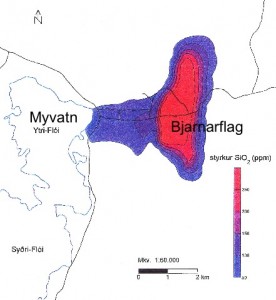 Framkvæmdir eru nú hafnar við Bjarnarflagsvirkjun. Oft hefur verið rætt um hugsanlega kólnun svæðisins vegna vinnslunnar. Kólni svæðið mun það leiða af sér minna kísilstreymi til Mývatns, en kísilmagn í vatni fer eftir vatnshitanum. Núna berast með jarðhitavatni um 10 tonn af kísli á dag til Mývatns og er hann undirstaða undir hinni auðugu kísilþörungaflóru þar.
Framkvæmdir eru nú hafnar við Bjarnarflagsvirkjun. Oft hefur verið rætt um hugsanlega kólnun svæðisins vegna vinnslunnar. Kólni svæðið mun það leiða af sér minna kísilstreymi til Mývatns, en kísilmagn í vatni fer eftir vatnshitanum. Núna berast með jarðhitavatni um 10 tonn af kísli á dag til Mývatns og er hann undirstaða undir hinni auðugu kísilþörungaflóru þar.
En mun svæðið kólna við vinnsluna? Fræðimenn eru ekki sammála um það. Í matsskýrslu frá 1999 eftir Stefán Arnórsson, Jónas Elíasson og Björn Þór Guðmundsson er sagt: ,,Nýting jarðhita á Námafjallssvæðinu með byggingu 40 MW gufurafstöðvar leiðir óhjákvæmilega til niðurdráttar í svæðinu og gæti með tímanum dregið úr, eða jafnvel stöðvað náttúrulegt frárennsli heits vatns frá því.“ Í annarri matsskýrslu, eftir Axel Björnsson frá 2001, segir að ,,… þrýstingslækkun í Bjarnarflagi muni verða lítil við 40 MW virkjun og að hverfandi líkur séu á að kalt grunnvatn muni leita að ofan eða frá hliðunum inn í jarðhitakerfið og koma þannig í veg fyrir hitun grunnvatnsstraumsins frá yfirborði.“
En málið er flóknara. Samkvæmt skýrslu frá verkfræðistofunni Vatnaskilum frá 1999 getur vinnslan minnkað náttúrulegt RENNSLI heita vatnsins til Mývatns og þar af leiðandi magn uppleystra efna eins og kísils. Meðfylgjandi mynd er úr þeirri skýrslu, en hún sýnir kísilstrauminn frá Bjarnarflagi til Mývatns.
Construction work for the Bjarnarflag geothermal power plant is now underway. The power plant is located near Lake Myvatn and there has been discussion about the possible cooling of the groundwater system due to the operation. If this happens, this will lead to less inflow of silica rich water into the lake. Today 10 tons of silica flow into the lake every day with natural geothermal water and forms the basis for its extremely rich flora of tiny one-celled algae called diatoms.
But will the groundwater cool down? Scientists have divided opinions on this. In a report from 1999 by three specialists it is stated that the utilization of geothermal energy in the area by a 40 MW power plant will inevitably lead to a drawdown of the groundwater table and could gradually decrease or shut down the natural flow of warm groundwater from it. In another report from 2001, also by a specialist, it is stated that the drawdown effect will be small and the probability of cooling by inflow of cold water will be negligible.
But the issue is more complicated. A third report, from yet another specialist in 1999, states that the VOLUME of the groundwater flow could diminish, leading to less Silica in Lake Myvatn. The figure is from this last mentioned report and shows the stream of warm groundwater (as Silica concentration) from the Bjarnarflag geothermal area to Lake Myvatn.
